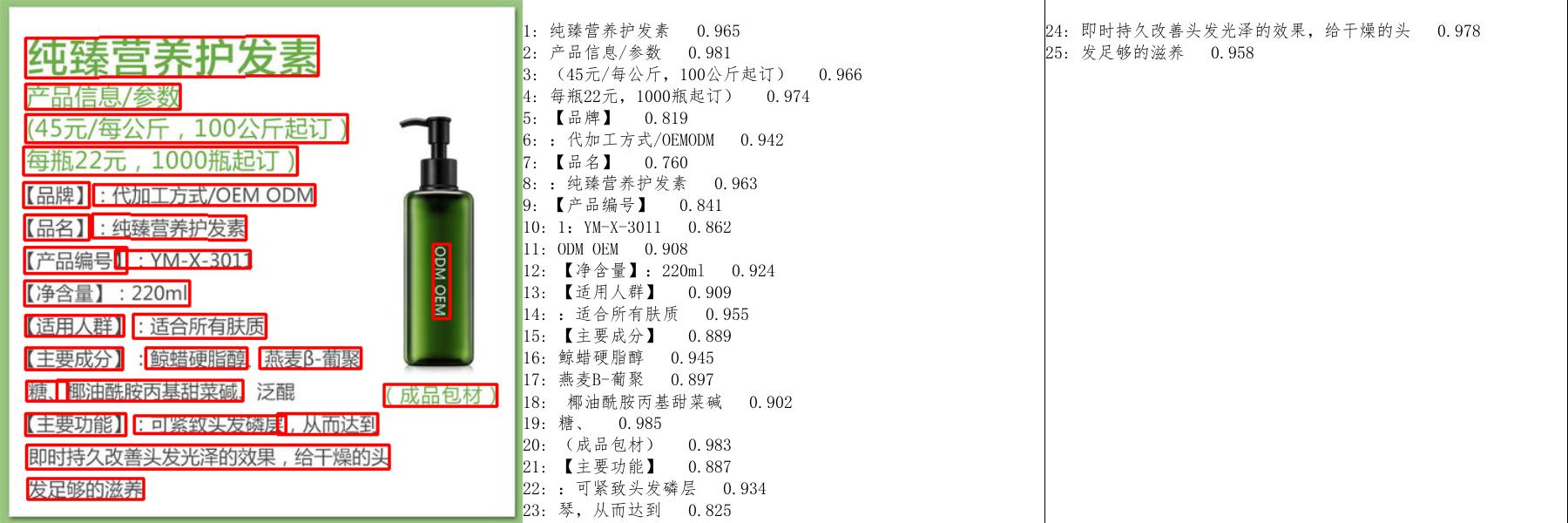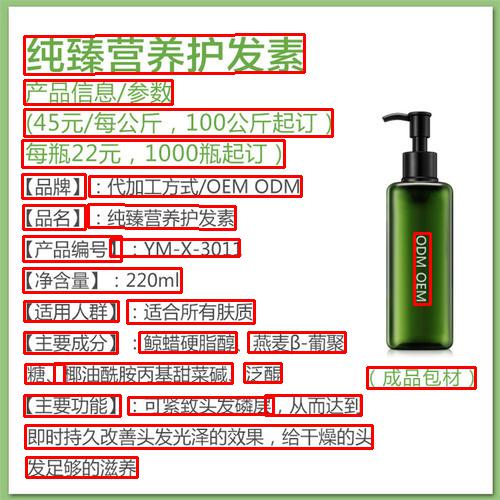# paddleocr package使用说明
## 1 快速上手
### 1.1 安装whl包
pip安装
```bash
pip install "paddleocr>=2.0.1" # 推荐使用2.0.1+版本
```
本地构建并安装
```bash
python3 setup.py bdist_wheel
pip3 install dist/paddleocr-x.x.x-py3-none-any.whl # x.x.x是paddleocr的版本号
```
## 2 使用
### 2.1 代码使用
paddleocr whl包会自动下载ppocr轻量级模型作为默认模型,可以根据第3节**自定义模型**进行自定义更换。
* 检测+方向分类器+识别全流程
```python
from paddleocr import PaddleOCR, draw_ocr
# Paddleocr目前支持中英文、英文、法语、德语、韩语、日语,可以通过修改lang参数进行切换
# 参数依次为`ch`, `en`, `french`, `german`, `korean`, `japan`。
ocr = PaddleOCR(use_angle_cls=True, lang="ch") # need to run only once to download and load model into memory
img_path = 'PaddleOCR/doc/imgs/11.jpg'
result = ocr.ocr(img_path, cls=True)
for idx in range(len(result)):
res = result[idx]
for line in res:
print(line)
# 显示结果
from PIL import Image
result = result[0]
image = Image.open(img_path).convert('RGB')
boxes = [line[0] for line in result]
txts = [line[1][0] for line in result]
scores = [line[1][1] for line in result]
im_show = draw_ocr(image, boxes, txts, scores, font_path='/path/to/PaddleOCR/doc/fonts/simfang.ttf')
im_show = Image.fromarray(im_show)
im_show.save('result.jpg')
```
结果是一个list,每个item包含了文本框,文字和识别置信度
```bash
[[[24.0, 36.0], [304.0, 34.0], [304.0, 72.0], [24.0, 74.0]], ['纯臻营养护发素', 0.964739]]
[[[24.0, 80.0], [172.0, 80.0], [172.0, 104.0], [24.0, 104.0]], ['产品信息/参数', 0.98069626]]
[[[24.0, 109.0], [333.0, 109.0], [333.0, 136.0], [24.0, 136.0]], ['(45元/每公斤,100公斤起订)', 0.9676722]]
......
```
结果可视化
* 检测+识别
```python
from paddleocr import PaddleOCR, draw_ocr
ocr = PaddleOCR() # need to run only once to download and load model into memory
img_path = 'PaddleOCR/doc/imgs/11.jpg'
result = ocr.ocr(img_path, cls=False)
for idx in range(len(result)):
res = result[idx]
for line in res:
print(line)
# 显示结果
from PIL import Image
result = result[0]
image = Image.open(img_path).convert('RGB')
boxes = [line[0] for line in result]
txts = [line[1][0] for line in result]
scores = [line[1][1] for line in result]
im_show = draw_ocr(image, boxes, txts, scores, font_path='/path/to/PaddleOCR/doc/fonts/simfang.ttf')
im_show = Image.fromarray(im_show)
im_show.save('result.jpg')
```
结果是一个list,每个item包含了文本框,文字和识别置信度
```bash
[[[24.0, 36.0], [304.0, 34.0], [304.0, 72.0], [24.0, 74.0]], ['纯臻营养护发素', 0.964739]]
[[[24.0, 80.0], [172.0, 80.0], [172.0, 104.0], [24.0, 104.0]], ['产品信息/参数', 0.98069626]]
[[[24.0, 109.0], [333.0, 109.0], [333.0, 136.0], [24.0, 136.0]], ['(45元/每公斤,100公斤起订)', 0.9676722]]
......
```
结果可视化
* 方向分类器+识别
```python
from paddleocr import PaddleOCR
ocr = PaddleOCR(use_angle_cls=True) # need to run only once to download and load model into memory
img_path = 'PaddleOCR/doc/imgs_words/ch/word_1.jpg'
result = ocr.ocr(img_path, det=False, cls=True)
for idx in range(len(result)):
res = result[idx]
for line in res:
print(line)
```
结果是一个list,每个item只包含识别结果和识别置信度
```bash
['韩国小馆', 0.9907421]
```
* 单独执行检测
```python
from paddleocr import PaddleOCR, draw_ocr
ocr = PaddleOCR() # need to run only once to download and load model into memory
img_path = 'PaddleOCR/doc/imgs/11.jpg'
result = ocr.ocr(img_path, rec=False)
for idx in range(len(result)):
res = result[idx]
for line in res:
print(line)
# 显示结果
from PIL import Image
result = result[0]
image = Image.open(img_path).convert('RGB')
im_show = draw_ocr(image, result, txts=None, scores=None, font_path='/path/to/PaddleOCR/doc/fonts/simfang.ttf')
im_show = Image.fromarray(im_show)
im_show.save('result.jpg')
```
结果是一个list,每个item只包含文本框
```bash
[[26.0, 457.0], [137.0, 457.0], [137.0, 477.0], [26.0, 477.0]]
[[25.0, 425.0], [372.0, 425.0], [372.0, 448.0], [25.0, 448.0]]
[[128.0, 397.0], [273.0, 397.0], [273.0, 414.0], [128.0, 414.0]]
......
```
结果可视化
* 单独执行识别
```python
from paddleocr import PaddleOCR
ocr = PaddleOCR() # need to run only once to download and load model into memory
img_path = 'PaddleOCR/doc/imgs_words/ch/word_1.jpg'
result = ocr.ocr(img_path, det=False)
for idx in range(len(result)):
res = result[idx]
for line in res:
print(line)
```
结果是一个list,每个item只包含识别结果和识别置信度
```bash
['韩国小馆', 0.9907421]
```
* 单独执行方向分类器
```python
from paddleocr import PaddleOCR
ocr = PaddleOCR(use_angle_cls=True) # need to run only once to download and load model into memory
img_path = 'PaddleOCR/doc/imgs_words/ch/word_1.jpg'
result = ocr.ocr(img_path, det=False, rec=False, cls=True)
for idx in range(len(result)):
res = result[idx]
for line in res:
print(line)
```
结果是一个list,每个item只包含分类结果和分类置信度
```bash
['0', 0.9999924]
```
### 2.2 通过命令行使用
查看帮助信息
```bash
paddleocr -h
```
* 检测+方向分类器+识别全流程
```bash
paddleocr --image_dir PaddleOCR/doc/imgs/11.jpg --use_angle_cls true
```
结果是一个list,每个item包含了文本框,文字和识别置信度
```bash
[[[28.0, 37.0], [302.0, 39.0], [302.0, 72.0], [27.0, 70.0]], ('纯臻营养护发素', 0.9658738374710083)]
......
```
此外,paddleocr也支持输入pdf文件,并且可以通过指定参数`page_num`来控制推理前面几页,默认为0,表示推理所有页。
```bash
paddleocr --image_dir ./xxx.pdf --use_angle_cls true --use_gpu false --page_num 2
```
* 检测+识别
```bash
paddleocr --image_dir PaddleOCR/doc/imgs/11.jpg
```
结果是一个list,每个item包含了文本框,文字和识别置信度
```bash
[[[28.0, 37.0], [302.0, 39.0], [302.0, 72.0], [27.0, 70.0]], ('纯臻营养护发素', 0.9658738374710083)]
......
```
* 方向分类器+识别
```bash
paddleocr --image_dir PaddleOCR/doc/imgs_words/ch/word_1.jpg --use_angle_cls true --det false
```
结果是一个list,每个item只包含识别结果和识别置信度
```bash
['韩国小馆', 0.994467]
```
* 单独执行检测
```bash
paddleocr --image_dir PaddleOCR/doc/imgs/11.jpg --rec false
```
结果是一个list,每个item只包含文本框
```bash
[[27.0, 459.0], [136.0, 459.0], [136.0, 479.0], [27.0, 479.0]]
[[28.0, 429.0], [372.0, 429.0], [372.0, 445.0], [28.0, 445.0]]
......
```
* 单独执行识别
```bash
paddleocr --image_dir PaddleOCR/doc/imgs_words/ch/word_1.jpg --det false
```
结果是一个list,每个item只包含识别结果和识别置信度
```bash
['韩国小馆', 0.994467]
```
* 单独执行方向分类器
```bash
paddleocr --image_dir PaddleOCR/doc/imgs_words/ch/word_1.jpg --use_angle_cls true --det false --rec false
```
结果是一个list,每个item只包含分类结果和分类置信度
```bash
['0', 0.9999924]
```
## 3 自定义模型
当内置模型无法满足需求时,需要使用到自己训练的模型。 首先,参照[模型导出](./detection.md#4-模型导出与预测)将检测、分类和识别模型转换为inference模型,然后按照如下方式使用
### 3.1 代码使用
```python
from paddleocr import PaddleOCR, draw_ocr
# 模型路径下必须含有model和params文件
ocr = PaddleOCR(det_model_dir='{your_det_model_dir}', rec_model_dir='{your_rec_model_dir}',
rec_char_dict_path='{your_rec_char_dict_path}', cls_model_dir='{your_cls_model_dir}',
use_angle_cls=True)
img_path = 'PaddleOCR/doc/imgs/11.jpg'
result = ocr.ocr(img_path, cls=True)
for idx in range(len(result)):
res = result[idx]
for line in res:
print(line)
# 显示结果
from PIL import Image
result = result[0]
image = Image.open(img_path).convert('RGB')
boxes = [line[0] for line in result]
txts = [line[1][0] for line in result]
scores = [line[1][1] for line in result]
im_show = draw_ocr(image, boxes, txts, scores, font_path='/path/to/PaddleOCR/doc/fonts/simfang.ttf')
im_show = Image.fromarray(im_show)
im_show.save('result.jpg')
```
### 3.2 通过命令行使用
```bash
paddleocr --image_dir PaddleOCR/doc/imgs/11.jpg --det_model_dir {your_det_model_dir} --rec_model_dir {your_rec_model_dir} --rec_char_dict_path {your_rec_char_dict_path} --cls_model_dir {your_cls_model_dir} --use_angle_cls true
```
## 4 使用网络图片或者numpy数组作为输入
### 4.1 网络图片
- 代码使用
```python
from paddleocr import PaddleOCR, draw_ocr, download_with_progressbar
# Paddleocr目前支持中英文、英文、法语、德语、韩语、日语,可以通过修改lang参数进行切换
# 参数依次为`ch`, `en`, `french`, `german`, `korean`, `japan`。
ocr = PaddleOCR(use_angle_cls=True, lang="ch") # need to run only once to download and load model into memory
img_path = 'http://n.sinaimg.cn/ent/transform/w630h933/20171222/o111-fypvuqf1838418.jpg'
result = ocr.ocr(img_path, cls=True)
for idx in range(len(result)):
res = result[idx]
for line in res:
print(line)
# 显示结果
from PIL import Image
result = result[0]
download_with_progressbar(img_path, 'tmp.jpg')
image = Image.open('tmp.jpg').convert('RGB')
boxes = [line[0] for line in result]
txts = [line[1][0] for line in result]
scores = [line[1][1] for line in result]
im_show = draw_ocr(image, boxes, txts, scores, font_path='/path/to/PaddleOCR/doc/fonts/simfang.ttf')
im_show = Image.fromarray(im_show)
im_show.save('result.jpg')
```
- 命令行模式
```bash
paddleocr --image_dir http://n.sinaimg.cn/ent/transform/w630h933/20171222/o111-fypvuqf1838418.jpg --use_angle_cls=true
```
### 4.2 numpy数组
仅通过代码使用时支持numpy数组作为输入
```python
import cv2
from paddleocr import PaddleOCR, draw_ocr
# Paddleocr目前支持中英文、英文、法语、德语、韩语、日语,可以通过修改lang参数进行切换
# 参数依次为`ch`, `en`, `french`, `german`, `korean`, `japan`。
ocr = PaddleOCR(use_angle_cls=True, lang="ch") # need to run only once to download and load model into memory
img_path = 'PaddleOCR/doc/imgs/11.jpg'
img = cv2.imread(img_path)
# img = cv2.cvtColor(img,cv2.COLOR_BGR2GRAY), 如果你自己训练的模型支持灰度图,可以将这句话的注释取消
result = ocr.ocr(img, cls=True)
for idx in range(len(result)):
res = result[idx]
for line in res:
print(line)
# 显示结果
from PIL import Image
result = result[0]
image = Image.open(img_path).convert('RGB')
boxes = [line[0] for line in result]
txts = [line[1][0] for line in result]
scores = [line[1][1] for line in result]
im_show = draw_ocr(image, boxes, txts, scores, font_path='/path/to/PaddleOCR/doc/fonts/simfang.ttf')
im_show = Image.fromarray(im_show)
im_show.save('result.jpg')
```
## 5 PDF文件作为输入
- 命令行模式
可以通过指定参数`page_num`来控制推理前面几页,默认为0,表示推理所有页。
```bash
paddleocr --image_dir ./xxx.pdf --use_angle_cls true --use_gpu false --page_num 2
```
- 代码使用
```python
from paddleocr import PaddleOCR, draw_ocr
# Paddleocr目前支持的多语言语种可以通过修改lang参数进行切换
# 例如`ch`, `en`, `fr`, `german`, `korean`, `japan`
ocr = PaddleOCR(use_angle_cls=True, lang="ch", page_num=2) # need to run only once to download and load model into memory
img_path = './xxx.pdf'
result = ocr.ocr(img_path, cls=True)
for idx in range(len(result)):
res = result[idx]
for line in res:
print(line)
# 显示结果
import fitz
from PIL import Image
import cv2
import numpy as np
imgs = []
with fitz.open(img_path) as pdf:
for pg in range(0, pdf.pageCount):
page = pdf[pg]
mat = fitz.Matrix(2, 2)
pm = page.getPixmap(matrix=mat, alpha=False)
# if width or height > 2000 pixels, don't enlarge the image
if pm.width > 2000 or pm.height > 2000:
pm = page.getPixmap(matrix=fitz.Matrix(1, 1), alpha=False)
img = Image.frombytes("RGB", [pm.width, pm.height], pm.samples)
img = cv2.cvtColor(np.array(img), cv2.COLOR_RGB2BGR)
imgs.append(img)
for idx in range(len(result)):
res = result[idx]
image = imgs[idx]
boxes = [line[0] for line in res]
txts = [line[1][0] for line in res]
scores = [line[1][1] for line in res]
im_show = draw_ocr(image, boxes, txts, scores, font_path='doc/fonts/simfang.ttf')
im_show = Image.fromarray(im_show)
im_show.save('result_page_{}.jpg'.format(idx))
```
## 6 参数说明
| 字段 | 说明 | 默认值 |
|-------------------------|----------------------------------------------------------------------------------------------------------------------------------------------------------------------------------------------------------------------|-------------------------|
| use_gpu | 是否使用GPU | TRUE |
| gpu_mem | 初始化占用的GPU内存大小 | 8000M |
| image_dir | 通过命令行调用时执行预测的图片或文件夹路径 |
| page_num | 当输入类型为pdf文件时有效,指定预测前面page_num页,默认预测所有页 | 0 |
| det_algorithm | 使用的检测算法类型 | DB |
| det_model_dir | 检测模型所在文件夹。传参方式有两种,1. None: 自动下载内置模型到 `~/.paddleocr/det`;2.自己转换好的inference模型路径,模型路径下必须包含model和params文件 | None |
| det_max_side_len | 检测算法前向时图片长边的最大尺寸,当长边超出这个值时会将长边resize到这个大小,短边等比例缩放 | 960 |
| det_db_thresh | DB模型输出预测图的二值化阈值 | 0.3 |
| det_db_box_thresh | DB模型输出框的阈值,低于此值的预测框会被丢弃 | 0.5 |
| det_db_unclip_ratio | DB模型输出框扩大的比例 | 2 |
| det_db_score_mode | 计算检测框score的方式,有'fast'和'slow',如果要检测的文字有弯曲,建议用'slow','slow'模式计算的box的score偏大,box不容易被过滤掉 | 'fast' |
| det_east_score_thresh | EAST模型输出预测图的二值化阈值 | 0.8 |
| det_east_cover_thresh | EAST模型输出框的阈值,低于此值的预测框会被丢弃 | 0.1 |
| det_east_nms_thresh | EAST模型输出框NMS的阈值 | 0.2 |
| rec_algorithm | 使用的识别算法类型 | CRNN |
| rec_model_dir | 识别模型所在文件夹。传参方式有两种,1. None: 自动下载内置模型到 `~/.paddleocr/rec`;2.自己转换好的inference模型路径,模型路径下必须包含model和params文件 | None |
| rec_image_shape | 识别算法的输入图片尺寸 | "3,32,320" |
| rec_batch_num | 进行识别时,同时前向的图片数 | 30 |
| max_text_length | 识别算法能识别的最大文字长度 | 25 |
| rec_char_dict_path | 识别模型字典路径,当rec_model_dir使用方式2传参时需要修改为自己的字典路径 | ./ppocr/utils/ppocr_keys_v1.txt |
| use_space_char | 是否识别空格 | TRUE |
| drop_score | 对输出按照分数(来自于识别模型)进行过滤,低于此分数的不返回 | 0.5 |
| use_angle_cls | 是否加载分类模型 | FALSE |
| cls_model_dir | 分类模型所在文件夹。传参方式有两种,1. None: 自动下载内置模型到 `~/.paddleocr/cls`;2.自己转换好的inference模型路径,模型路径下必须包含model和params文件 | None |
| cls_image_shape | 分类算法的输入图片尺寸 | "3, 48, 192" |
| label_list | 分类算法的标签列表 | ['0', '180'] |
| cls_batch_num | 进行分类时,同时前向的图片数 |30 |
| enable_mkldnn | 是否启用mkldnn | FALSE |
| use_zero_copy_run | 是否通过zero_copy_run的方式进行前向 | FALSE |
| lang | 模型语言类型,目前支持 目前支持中英文(ch)、英文(en)、法语(french)、德语(german)、韩语(korean)、日语(japan) | ch |
| det | 前向时使用启动检测 | TRUE |
| rec | 前向时是否启动识别 | TRUE |
| cls | 前向时是否启动分类 (命令行模式下使用use_angle_cls控制前向是否启动分类) | FALSE |
| show_log | 是否打印logger信息 | FALSE |
| type | 执行ocr或者表格结构化, 值可选['ocr','structure'] | ocr |
| ocr_version | OCR模型版本,可选PP-OCRv3, PP-OCRv2, PP-OCR。PP-OCRv3 支持中、英文的检测、识别、多语种识别,方向分类器等模型;PP-OCRv2 目前仅支持中文的检测和识别模型;PP-OCR支持中文的检测,识别,多语种识别,方向分类器等模型 | PP-OCRv3 |



